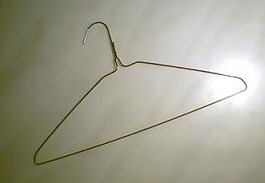Malcolm R. Campbell's Blog, page 49
July 4, 2022
Happy Birthday, USA

Dear USA,
You were conceived and safely delivered into the world 246 years ago with the highest of hopes that a republic had been born that would last for eternity, as Franklin said if we can keep it. You were nearly lost between 1861 and 1865 when 620,000 men died trying to keep you together and tear you apart.
Since then, you have given hope to many and taken away hope from others because every hatred and misstep you ever took remains in our collective psyche to haunt us and divide us and cause the meanspirited amongst us to keep trying to tear us apart. Some say you are in the middle of a “cold civil war,” the heat of which is seen in our cities at night.
Many of us think you are on the cusp of losing your way and that we’ll fall into limbo if the disparate voices aren’t willing to pull back a little from their most extreme beliefs and find a common ground. We need that common ground for, as Lincoln said, “A house divided against itself cannot stand.” At present, your people are very much divided.
Quite likely, I’m naïve and still believe you will long endure. I still believe there’s a chance for you, even now.
July 3, 2022
Labor Day Weekend means RAIN
 Happy 4th of July Weekend. If you live near me–and I feel safer knowing you probably don’t–then you’re having rain with more to come. After some of the news we’ve been seeing, I should probably say, “Rain, well that figures.” Note to those of you in Scotland, Northern Ireland, and Wales. It’s past time for y’all to declare independence from England, the U.K, the empire, or whatever it is these days. Don’t wait.
Happy 4th of July Weekend. If you live near me–and I feel safer knowing you probably don’t–then you’re having rain with more to come. After some of the news we’ve been seeing, I should probably say, “Rain, well that figures.” Note to those of you in Scotland, Northern Ireland, and Wales. It’s past time for y’all to declare independence from England, the U.K, the empire, or whatever it is these days. Don’t wait.
 Author Keith Willis, a long-time friend of mine, will soon be releasing the next book in his swashbuckling Knights of Kilbourne fantasy series. Stolen Knight, the 4th in the series, will be out soon. Keith and I met when I was an instructor and he was a student at Berry College in Rome, Georgia. He was better at being a student than I was at being an instructor. My excuse is that I got the job a few days before the first class and had to move down to Georgia from Minnesota in my half-broken town Jeep. No time to prepare for the kinds of courses I wanted to teach.
Author Keith Willis, a long-time friend of mine, will soon be releasing the next book in his swashbuckling Knights of Kilbourne fantasy series. Stolen Knight, the 4th in the series, will be out soon. Keith and I met when I was an instructor and he was a student at Berry College in Rome, Georgia. He was better at being a student than I was at being an instructor. My excuse is that I got the job a few days before the first class and had to move down to Georgia from Minnesota in my half-broken town Jeep. No time to prepare for the kinds of courses I wanted to teach.
 A few days ago, I wrote a post about author Thomas Savage. At least one reader has commented on the autobiography’s high price. That, unfortunately, is the way of things for University Press books. I don’t understand the thinking unlesss it comes from ther expectation that the book will be sold to other colleges and univerities with plenty of money. I meant to suggest a book you might start with if you’re new to Savage. A good place to start, I think, is with The Power of the Dog which Jane Campion made into a film by the same name in 2021.
A few days ago, I wrote a post about author Thomas Savage. At least one reader has commented on the autobiography’s high price. That, unfortunately, is the way of things for University Press books. I don’t understand the thinking unlesss it comes from ther expectation that the book will be sold to other colleges and univerities with plenty of money. I meant to suggest a book you might start with if you’re new to Savage. A good place to start, I think, is with The Power of the Dog which Jane Campion made into a film by the same name in 2021. For those of you who keep wanting to make stuff like chickpea salad, I should remind you that I don’t consider that kind of thing to be food, especially for a holiday weekend. It reminds me of the kind of stuff the cooks make on the TV show “Chopped.” Look at those judges for the show and ask them if they think the chefs who compete on the show are really cooking normal food. Hmm, I don’t think the judges are that blurry in “real life.”
For those of you who keep wanting to make stuff like chickpea salad, I should remind you that I don’t consider that kind of thing to be food, especially for a holiday weekend. It reminds me of the kind of stuff the cooks make on the TV show “Chopped.” Look at those judges for the show and ask them if they think the chefs who compete on the show are really cooking normal food. Hmm, I don’t think the judges are that blurry in “real life.” Speaking of food, I’m preparing Kraft Mac & Cheese of supper. I’m glad the company has finally updated their packaging to display the product as we refer to it. If they’d asked me, I would have suggested they add the words “comfort food” somewhere on the box.
Speaking of food, I’m preparing Kraft Mac & Cheese of supper. I’m glad the company has finally updated their packaging to display the product as we refer to it. If they’d asked me, I would have suggested they add the words “comfort food” somewhere on the box.
July 2, 2022
W. P. Kinsella’s magical realism in ‘Shoeless Joe’ and ‘The Iowa Baseball Confederacy’
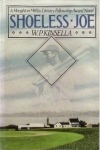 If you watched Ken Burns’ 1994 documentary “Baseball,” perhaps you felt the magic in the sport. PBS called the film, “An American epic overflowing with heroes and hopefuls, scoundrels and screwballs.” If you sense this magic at the ball field or even while watching a game on TV, perhaps you can understand why Canadian author W. P. Kinsella (1935-2016) used magical realism in Shoeless Joe, The Iowa Baseball Confederacy, and his later novel Butterfly Winter.
If you watched Ken Burns’ 1994 documentary “Baseball,” perhaps you felt the magic in the sport. PBS called the film, “An American epic overflowing with heroes and hopefuls, scoundrels and screwballs.” If you sense this magic at the ball field or even while watching a game on TV, perhaps you can understand why Canadian author W. P. Kinsella (1935-2016) used magical realism in Shoeless Joe, The Iowa Baseball Confederacy, and his later novel Butterfly Winter.
If you watched the feature film based on Shoeless Joe, “Field of Dreams,” or the movie version of “The Natural,” you might ask how anyone could write sincerely about baseball without magical realism. Shoeless Joe Jackson (1887-1951) was (and is) considered one of baseball best players with the third highest batting average in the major leagues. Even now, many dispute the claim he was involved in the 1919 “Black Sox scandal” in which White Sox players (including Jackson) were blamed for trying to throw the World Series against the Cincinnati Reds. Jackson–whose participation is doubted–was banned from baseball. In some ways, the book and film redeem him even though MLB never would.
 The spirit of the magic is aptly summed up in the New York Times review of Shoeless Joe that includes the following excerpt that appeared after a character was discovered to have been lying about his baseball experience: “I imagine Eddie Scissons has decided, ‘If I can’t have what I want most in life, then I’ll pretend I had it in the past, and talk about it and live it and relive it until it is real and solid and I can hold it to my heart like a precious child. Once I’ve experienced it so completely, no one can ever take it away from me.'”
The spirit of the magic is aptly summed up in the New York Times review of Shoeless Joe that includes the following excerpt that appeared after a character was discovered to have been lying about his baseball experience: “I imagine Eddie Scissons has decided, ‘If I can’t have what I want most in life, then I’ll pretend I had it in the past, and talk about it and live it and relive it until it is real and solid and I can hold it to my heart like a precious child. Once I’ve experienced it so completely, no one can ever take it away from me.'”
This is the way of sports. When actuality doesn’t meet our needs, dreams suffice.
 Wikipedia says,” The Iowa Baseball Confederacy (1986) another book blending fantasy and magical realism, recounts an epic baseball game a minor league team played against the 1908 World Champion Chicago Cubs” and Butterfly Winter as “The story of Julio and Esteban Pimental, twins whose divine destiny for baseball begins with games of catch in the womb, the novel marks a return to form, combining his long-held passions of baseball and magical realism.”
Wikipedia says,” The Iowa Baseball Confederacy (1986) another book blending fantasy and magical realism, recounts an epic baseball game a minor league team played against the 1908 World Champion Chicago Cubs” and Butterfly Winter as “The story of Julio and Esteban Pimental, twins whose divine destiny for baseball begins with games of catch in the womb, the novel marks a return to form, combining his long-held passions of baseball and magical realism.”
Great reading if you’re a baseball fan or even if you aren’t. Eitherway, you’ll suspect that magic exists by the time you get done reading the books.
Malcolm R. Campbell is the author of magical realism novels and short stories from Thomas-Jacob Publishing.
July 1, 2022
Looking for traditional western fiction and nonfiction: check the yearly Spur awards
Western fiction and nonfiction, as I’m using them here, mean traditional books set in the American West, though “Spur Awards” is probably a good tip-off to that. The awards, which are announced in March by the Western Writers of America often include books that a more varied than the old shoot-em-up stereotype of earlier western novels.
You can find the winners on the organization’s website here, though a software glitch is keeping the lists of winners prior to 2022 from displaying.
 According to the website, “Western Writers of America annually honors writers for distinguished writing about the American West with the Spur Awards. Since 1953 the Spur Awards have been considered one of the most prestigious awards in American literature. Spurs are given for the best western historical novel, best western traditional novel, best western contemporary novel, best short story, best short nonfiction. Also, best contemporary nonfiction, best biography, best history, best juvenile fiction and nonfiction, best drama, best documentary, and best first novel as well as best first nonfiction book.”
According to the website, “Western Writers of America annually honors writers for distinguished writing about the American West with the Spur Awards. Since 1953 the Spur Awards have been considered one of the most prestigious awards in American literature. Spurs are given for the best western historical novel, best western traditional novel, best western contemporary novel, best short story, best short nonfiction. Also, best contemporary nonfiction, best biography, best history, best juvenile fiction and nonfiction, best drama, best documentary, and best first novel as well as best first nonfiction book.”
 I’m especially interested in The Forgotten Botanist: Sara Plummer Lemmon’s Life of Science and Art by Wynne Brown which won a Spur for best biography this year. Books such as this are interesting for multiple reasons, one of them being they are great when an author is doing research. Even the titles of the winners and finalists can suggest new subjects for the curious author.
I’m especially interested in The Forgotten Botanist: Sara Plummer Lemmon’s Life of Science and Art by Wynne Brown which won a Spur for best biography this year. Books such as this are interesting for multiple reasons, one of them being they are great when an author is doing research. Even the titles of the winners and finalists can suggest new subjects for the curious author.
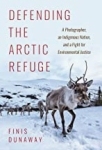 I’m also interested in Defending the Arctic Refuge: A Photographer, an Indigenous Nation, and a Fight for Environmental Justice by Finis Dunaway. The publisher’s description is more than enough to but this book on my TBR list: “Tucked away in the northeastern corner of Alaska is one of the most contested landscapes in all of North America: the Arctic National Wildlife Refuge. Considered sacred by Indigenous peoples in Alaska and Canada and treasured by environmentalists, the refuge provides life-sustaining habitat for caribou, polar bears, migratory birds, and other species. For decades, though, the fossil fuel industry and powerful politicians have sought to turn this unique ecosystem into an oil field. Defending the Arctic Refuge tells the improbable story of how the people fought back. At the center of the story is the unlikely figure of Lenny Kohm (1939–2014), a former jazz drummer and aspiring photographer who passionately committed himself to Arctic Refuge activism.”
I’m also interested in Defending the Arctic Refuge: A Photographer, an Indigenous Nation, and a Fight for Environmental Justice by Finis Dunaway. The publisher’s description is more than enough to but this book on my TBR list: “Tucked away in the northeastern corner of Alaska is one of the most contested landscapes in all of North America: the Arctic National Wildlife Refuge. Considered sacred by Indigenous peoples in Alaska and Canada and treasured by environmentalists, the refuge provides life-sustaining habitat for caribou, polar bears, migratory birds, and other species. For decades, though, the fossil fuel industry and powerful politicians have sought to turn this unique ecosystem into an oil field. Defending the Arctic Refuge tells the improbable story of how the people fought back. At the center of the story is the unlikely figure of Lenny Kohm (1939–2014), a former jazz drummer and aspiring photographer who passionately committed himself to Arctic Refuge activism.”
If you like traditional trapper, rancher, U.S. marshal, and other works, there’s a lot here to like, including Ridgeline, Dark Sky: A Joe Pickett Novel, and Cheyenne Summer: The Battle of Beecher Island: A History.
Good stuff, if you know where to look.
June 30, 2022
The nostalgia of Haynes Guides to Yellowstone
“Frank Jay Haynes (October 28, 1853 – March 10, 1921), known as F. Jay or the Professor to almost all who knew him, was a professional photographer, publisher, and entrepreneur from Minnesota who played a major role in documenting through photographs the settlement and early history of the great Northwest. He became both the official photographer of the Northern Pacific Railway and of Yellowstone National Park as well as operating early transportation concessions in the park. His photographs were widely published in articles, journals, books and turned into stereographs, and postcards in the late 19th and early 20th century.” – Wikipedia
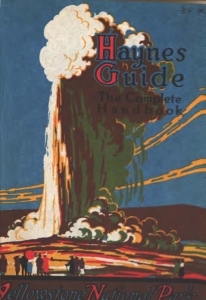 According to Yellowstone Forever, “In 1884, Haynes opened a photography store and studio at Mammoth Hot Springs. This would be the first of numerous such photo shops to be erected throughout the park. Haynes was, for all intents and purposes, the official photographer of Yellowstone National Park for years to come. His dedication to the park and to photography was carried on by his son, Jack Ellis Haynes. Millions of photographs, postcards, guidebooks, and souvenirs later, the Haynes family came to have a great impact in bringing Yellowstone to the world.”
According to Yellowstone Forever, “In 1884, Haynes opened a photography store and studio at Mammoth Hot Springs. This would be the first of numerous such photo shops to be erected throughout the park. Haynes was, for all intents and purposes, the official photographer of Yellowstone National Park for years to come. His dedication to the park and to photography was carried on by his son, Jack Ellis Haynes. Millions of photographs, postcards, guidebooks, and souvenirs later, the Haynes family came to have a great impact in bringing Yellowstone to the world.”
His prolific output included a yearly Haynes Guide to Yellowstone that, with the later management of his son Jack, was published up until 1966. The heavily illustrated guides included maps, points of interest, and park rules and regulations. You can find a downloadable PDF of the 1916 guide here. These guides come up for sale at online booksellers and eBay from time to time. Many of Haynes’ early popular color photographs were hand-tinted. He also found success with his stereo camera and the resulting stereographs as well as a bulky camera that produced images on 20″ x 24″ glass plate negatives that showed a great deal of detail.
The preface of the 1916 edition shows that Haynes had an extensive vision of what the guides should accomplish: “The purpose of this book is to guide the tourist on his tour of Yellowstone National Park and to make his visit pleasant and interesting. To this end, it names, describes, and pictures all the points of interest in the park and presents in concise and readable form the scientific and historical information necessary to a clear understanding of the various phenomena.”
 Haynes served as the official photographer for Yellowstone National Park as well as the Northern Pacific Railway. The railroad, which served the park, had a fair amount of interest in promoting Yellowstone just as the Great Northern Railway was instrumental in the development and promotion of Montana’s Glacier National Park.
Haynes served as the official photographer for Yellowstone National Park as well as the Northern Pacific Railway. The railroad, which served the park, had a fair amount of interest in promoting Yellowstone just as the Great Northern Railway was instrumental in the development and promotion of Montana’s Glacier National Park.
Because of his enthusiasm and enormous photographic output, Haynes was well-positioned to provide the stuff of which the park guides were based. Jeff Malcolmson, in “A Photographic Journey to Wonderland” (Montana The Magazine of Western History, Summer 2022) writes that Haynes’ “First journey into Yellowstone would define the trajectory of his career as perhaps the most prominent early photographer of the park.”
In his cutline for the portrait of Haynes, Malcomson says, “Note that he is armed with a revolver and a knife, ready to do battle with any wildlife” Personally, I don’t think either would be very effective against a charging grizzly. I’d rather have bear spray (not pepper spray).
When I was in Yellowstone in 1965, I wish I’d been aware of the guides. I would have purchased a copy of the penultimate edition even if it would be some years before I discovered what a treasure I had.
June 29, 2022
New Title: ‘Savage West: The Life and Fiction of Thomas Savage’
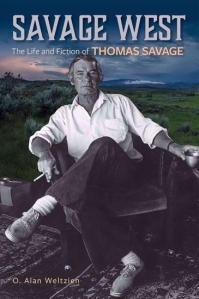 “Thomas Savage (April 25, 1915 – July 25, 2003) was an American author of novels published between 1944 and 1988. He is best known for his Western novels, which drew on early experiences in the American West. – Wikipedia”
“Thomas Savage (April 25, 1915 – July 25, 2003) was an American author of novels published between 1944 and 1988. He is best known for his Western novels, which drew on early experiences in the American West. – Wikipedia”
For the popularity and success of his unique western novels and the awards he received, Thomas Savage (The Power of the Dog and others) is more obscure than he should be. O. Alan Weltzien hopes to change that with his 257-page biography published by the University of Nevada Press in January.
The book is available in hardcover, paperback, and e-book.
From the PublisherThomas Savage (1915-2003) was one of the intermountain West’s best novelists. His thirteen novels received high critical praise, yet he remained largely unknown by readers. Although Savage spent much of his later life in the Northeast, his formative years were spent in southwestern Montana, where the mountain West and his ranching family formed the setting for much of his work.
O. Alan Weltzien’s insightful and detailed literary biography chronicles the life and work of this neglected but deeply talented novelist. Savage, a closeted gay family man, was both an outsider and an insider, navigating an intense conflict between his sexual identity and the claustrophobic social restraints of the rural West.
Unlike many other Western writers, Savage avoided the formula westerns –so popular in his time– and offered instead a realistic, often subversive version of the region. His novels tell a hard, harsh story about dysfunctional families, loneliness, and stifling provincialism in the small towns and ranches of the northern Rockies, and his minority interpretation of the West provides a unique vision and caustic counternarrative contrary to the triumphant settler-colonialism themes that have shaped most Western literature.
Savage West seeks to claim Thomas Savage’s well-deserved position in American literature and to reintroduce twenty-first-century readers to a major Montana writer.
From the Introduction“In her Publishers Weekly interview with Savage (July 15, 1988), Francesca Coltrera called Savage ‘a balladeer, almost, of the American scene.’ If so, Savage’s ballads, like many of his best known, sing sad stories, but it’s more than that. Particularly in the eight novels set in southwestern Montana and Idaho’s Lemhi River Valley, Savage wields an acidic brush, one that goes against the gain of triumphal stories of white pioneers and their prospering or floundering descendants. Savage prefers anti-heroic, acerbic flavors. His stylistic wit and play, especially his essayistic interludes, expose grim realities and lonely spaces.”
June 26, 2022
Sunday’s gumbo, &c
 I’m picky when it comes to gumbo. I prefer cajun to creole and okra to filé powder. Yet, for today’s post, it’s a great symbol for a tasty mix. You might need some antacids if you’re not used to it.Today at 1:52 p. m. the temperature here in Georgia is 91°. The weather forecasters keep saying we have a chance of rain. They’re talking about imaginary rain. Or, possibly, in-your-dreams kinds of rain.
I’m picky when it comes to gumbo. I prefer cajun to creole and okra to filé powder. Yet, for today’s post, it’s a great symbol for a tasty mix. You might need some antacids if you’re not used to it.Today at 1:52 p. m. the temperature here in Georgia is 91°. The weather forecasters keep saying we have a chance of rain. They’re talking about imaginary rain. Or, possibly, in-your-dreams kinds of rain.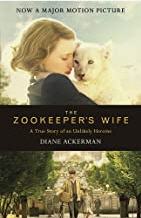 I’ve just finished re-reading
The Zoo Keeper’s Wife
. I’m impressed by the willingness of people to fight, hide Jews who are escaping from the Ghetto, and risk their lives sabotaging the Nazis. I hope that if Americans face similar circumstances, they will be as strong as the people in Warsaw. (And Ukraine, of course.)When it comes to the Supreme Court’s action in overturning Roe v Wade, I dissent. And if the justices were bound and determined to tinker with precedent, I agree with the Chief Justice that the court went too far. To counteract the most meanspirited states, the court should have declared it’s a violation of equality and liberty rights to force a woman to give birth to a child created out of rape or incest. Women will also need protection from arrest for having a miscarriage.
I’ve just finished re-reading
The Zoo Keeper’s Wife
. I’m impressed by the willingness of people to fight, hide Jews who are escaping from the Ghetto, and risk their lives sabotaging the Nazis. I hope that if Americans face similar circumstances, they will be as strong as the people in Warsaw. (And Ukraine, of course.)When it comes to the Supreme Court’s action in overturning Roe v Wade, I dissent. And if the justices were bound and determined to tinker with precedent, I agree with the Chief Justice that the court went too far. To counteract the most meanspirited states, the court should have declared it’s a violation of equality and liberty rights to force a woman to give birth to a child created out of rape or incest. Women will also need protection from arrest for having a miscarriage. This Facebook meme is especially apt this week. Speaking of Facebook, and I’d rather not, it still hasn’t addressed the software fault on my author’s page. I have unpublished it, and it will go away forever if the fault isn’t fixed before the count-down-to-deletion ends. (13 days from the day I unpublished it.) Some people say that Facebook doesn’t need support because everyday users aren’t their customers. I beg to differ inasmuch as the company wants me to see my page as a business, one where I spend money to advertise my books and “boost” posts for wider audiences.
This Facebook meme is especially apt this week. Speaking of Facebook, and I’d rather not, it still hasn’t addressed the software fault on my author’s page. I have unpublished it, and it will go away forever if the fault isn’t fixed before the count-down-to-deletion ends. (13 days from the day I unpublished it.) Some people say that Facebook doesn’t need support because everyday users aren’t their customers. I beg to differ inasmuch as the company wants me to see my page as a business, one where I spend money to advertise my books and “boost” posts for wider audiences. Filed under
cute animal news
in the Literary Hub, is this turned out to be an interesting article: “Do Birds Dream About Their Own Birdsong?” As I read it, I found myself wondering, “Why have I never thought about this before?”And, under “frightening news” we find this story in the Desert Sun: “Leave it to the Westerners to come up with solutions to their problems by causing problems for others. Las Vegas resident Bill Nichols’ June 22 suggestion of diverting Mississippi River water to the Southwest to help solve the Southwest’s drought problem is nothing more than a plan to steal, under federal-government oversight at taxpayers’ expense, water that belongs to the Midwest.” Nichols probably got this idea from the mayor of Los Angeles.
Filed under
cute animal news
in the Literary Hub, is this turned out to be an interesting article: “Do Birds Dream About Their Own Birdsong?” As I read it, I found myself wondering, “Why have I never thought about this before?”And, under “frightening news” we find this story in the Desert Sun: “Leave it to the Westerners to come up with solutions to their problems by causing problems for others. Las Vegas resident Bill Nichols’ June 22 suggestion of diverting Mississippi River water to the Southwest to help solve the Southwest’s drought problem is nothing more than a plan to steal, under federal-government oversight at taxpayers’ expense, water that belongs to the Midwest.” Nichols probably got this idea from the mayor of Los Angeles.Enjoy your bowl of gumbo,
June 24, 2022
June 23, 2022
Nostalgia: old airliners and military planes
I can’t remember all the aircraft I’ve flown on. They would include the Convair, Fairchild, and Fokker. For a while, I probably logged more miles in DC-9s and 727s since they flew back and forth between Atlanta and Tallahassee. Lesa was not a fan of the DC9 because she thought pilots flew it like a hotrod. It was a tough, gritty plane.
 The first large plane I flew on was the DC-8. I flew it between Luxembourg and New York City (with a brief stop in Iceland) and between Manilla and California. Both flights must have been smooth because my main memory was being asleep for most of both trips except when the flight attendants woke me up to eat again and again.
The first large plane I flew on was the DC-8. I flew it between Luxembourg and New York City (with a brief stop in Iceland) and between Manilla and California. Both flights must have been smooth because my main memory was being asleep for most of both trips except when the flight attendants woke me up to eat again and again.
 My favorite plane was the L-1011 (TriStar), very technologically advanced when it appeared in 1972, even though it certainly had a lot of people in that center section where the windows seemed several miles away. I think these were retired much too soon. Delta and Eastern flew these, so I saw a fair number of them.
My favorite plane was the L-1011 (TriStar), very technologically advanced when it appeared in 1972, even though it certainly had a lot of people in that center section where the windows seemed several miles away. I think these were retired much too soon. Delta and Eastern flew these, so I saw a fair number of them.
 The strangest plane I flew on was the Grumman HU-16 Albatross. These were used by the Navy and Air Force for search and rescue operations and could be configured as a seaplane, though the one I flew on in the Philippines was land-based. Jimmy Buffett flew the seaplane.
The strangest plane I flew on was the Grumman HU-16 Albatross. These were used by the Navy and Air Force for search and rescue operations and could be configured as a seaplane, though the one I flew on in the Philippines was land-based. Jimmy Buffett flew the seaplane.
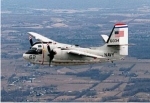 The Albatross typically carried 10 passengers. The Grumman C-1 Trader typically carried nine, though its main role in the 1960s and 1970s was bringing mail and/or flag-level staff to aircraft carriers. While it was capable of taking off from a carrier without using the catapult, the time I flew between the USS Ranger and Da Nang, we were catapulted off. That was a bit rougher than a DC-9 taking off from Tallahassee.
The Albatross typically carried 10 passengers. The Grumman C-1 Trader typically carried nine, though its main role in the 1960s and 1970s was bringing mail and/or flag-level staff to aircraft carriers. While it was capable of taking off from a carrier without using the catapult, the time I flew between the USS Ranger and Da Nang, we were catapulted off. That was a bit rougher than a DC-9 taking off from Tallahassee.
 The DC-3 I flew on in the Boy Scouts seemed rather ancient and it was for a special trip out of the Tallahassee airport down to the coast and back. This would have been in the late 1950s. My biggest surprise was seeing the Gulf of Mexico right after we took off. Oddly enough, a few airlines and cargo operators are still flying this 1935 aircraft.
The DC-3 I flew on in the Boy Scouts seemed rather ancient and it was for a special trip out of the Tallahassee airport down to the coast and back. This would have been in the late 1950s. My biggest surprise was seeing the Gulf of Mexico right after we took off. Oddly enough, a few airlines and cargo operators are still flying this 1935 aircraft.
Okay, thanks for putting up with my trip down memory lane. Obviously, I’ve been on other planes, including the DC-10, MD-80, and the 757. (Don’t sit in the rear section of the 757.) Never was on a 747. Sigh.
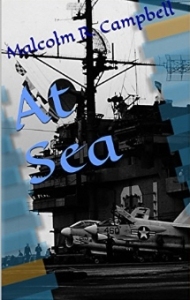 Malcolm R. Campbell is the author of At Sea, a Vietnam war novel. I took the cover photo but taking pictures on the flight deck didn’t get me a ride on any of our fighter jets.
Malcolm R. Campbell is the author of At Sea, a Vietnam war novel. I took the cover photo but taking pictures on the flight deck didn’t get me a ride on any of our fighter jets.
June 22, 2022
Good afternoon, riding mower fans
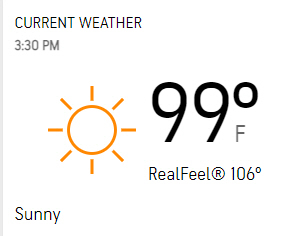 Today’s special event (let’s help Malcolm mow his yard) has been canceled due to hot weather. Even CNN, which normally stays quiet about news it doesn’t like, posted numerous stories about the heat, noting among other things that heat will be bad in the South. Duh. Apparently, the weather system is centered around Mempis. Those of us who live in Georgia think all bad weather begins in Memphis.
Today’s special event (let’s help Malcolm mow his yard) has been canceled due to hot weather. Even CNN, which normally stays quiet about news it doesn’t like, posted numerous stories about the heat, noting among other things that heat will be bad in the South. Duh. Apparently, the weather system is centered around Mempis. Those of us who live in Georgia think all bad weather begins in Memphis.
I didn’t see much hope for tomorrow or the day after in this news story: The worst of the latest heat wave is expected to be in the South, with triple-digit temperatures possible in Dallas, Houston, Austin and San Antonio in Texas, and New Orleans and Atlanta. And there’s no relief in sight. About 65% of the entire US population will see temperatures above 90 degrees over the next week, and almost 60 million will be sweltering in temperatures at or above 100. – CNN
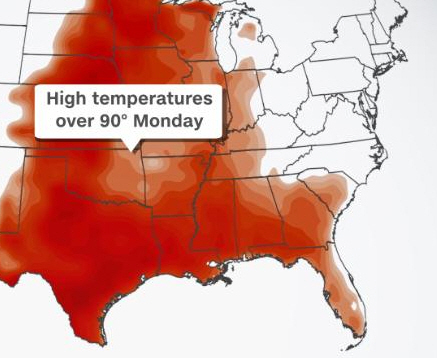 CNN Map as of two days ago
CNN Map as of two days ago(For those of you who are unsure just where North Georgia is, we’re 56 miles northwest of Atlanta as the crow flies.)
{Looking at the lame jokes page, I see: “The potatoes cook underground, and all you have to do to have lunch is to pull one out and add butter, salt, and pepper.” It’s probably true along with farmers feeding chickens crushed ice so they won’t lay hardboiled eggs.}
Here in Rome, GA, we no longer laugh at those jokes. However, if EMTs respond to your house because you’re a victim of heat stroke, they’ll take you straight to the morgue where the cool air might revive you. If not, you’re where you’ll end up anyway.
Btw, my apologies to hard-core lawn-mowing aficionados who believe a standard riding mower should be called a “lawn tractor.”
Those of you wondering when the next scheduled let’s help Malcolm mow his yard is scheduled, stop by as soon as it (the sky) starts raining. As always, there will be sweet tea for those doing the mowing and beer for the kids.
P.S. If you look online and see that you can tell Facebook your problems by sending them (the problems) to support@fb.com, don’t bother. Anything sent to that e-mail address bounces back.

